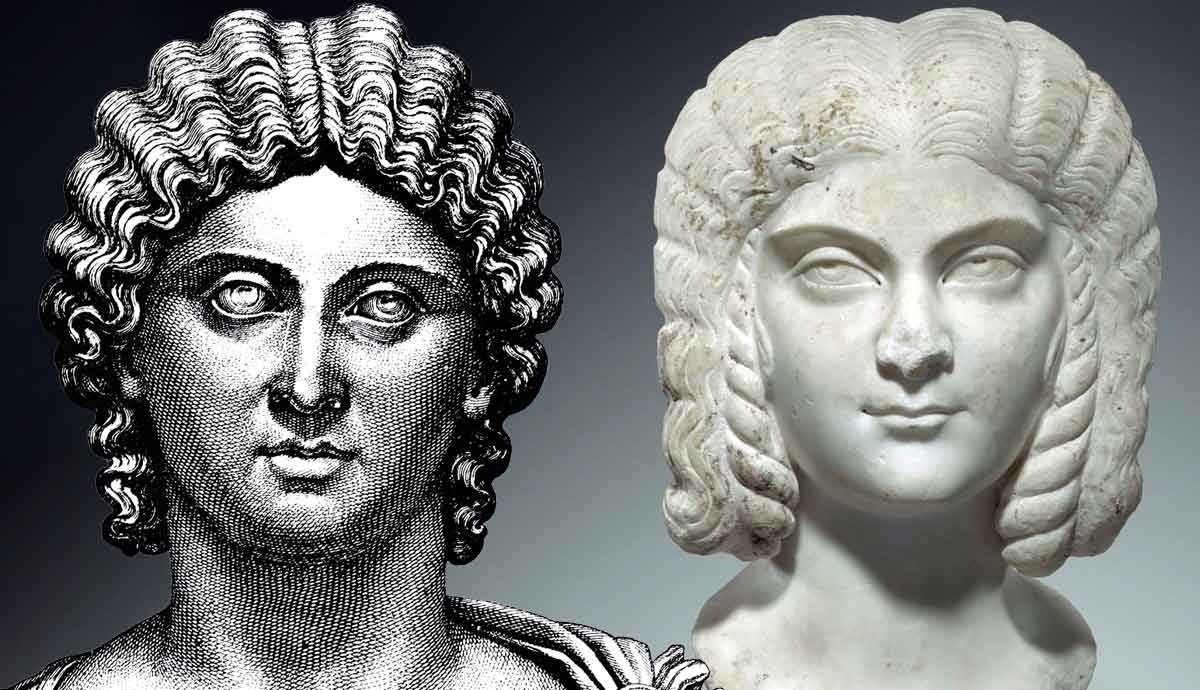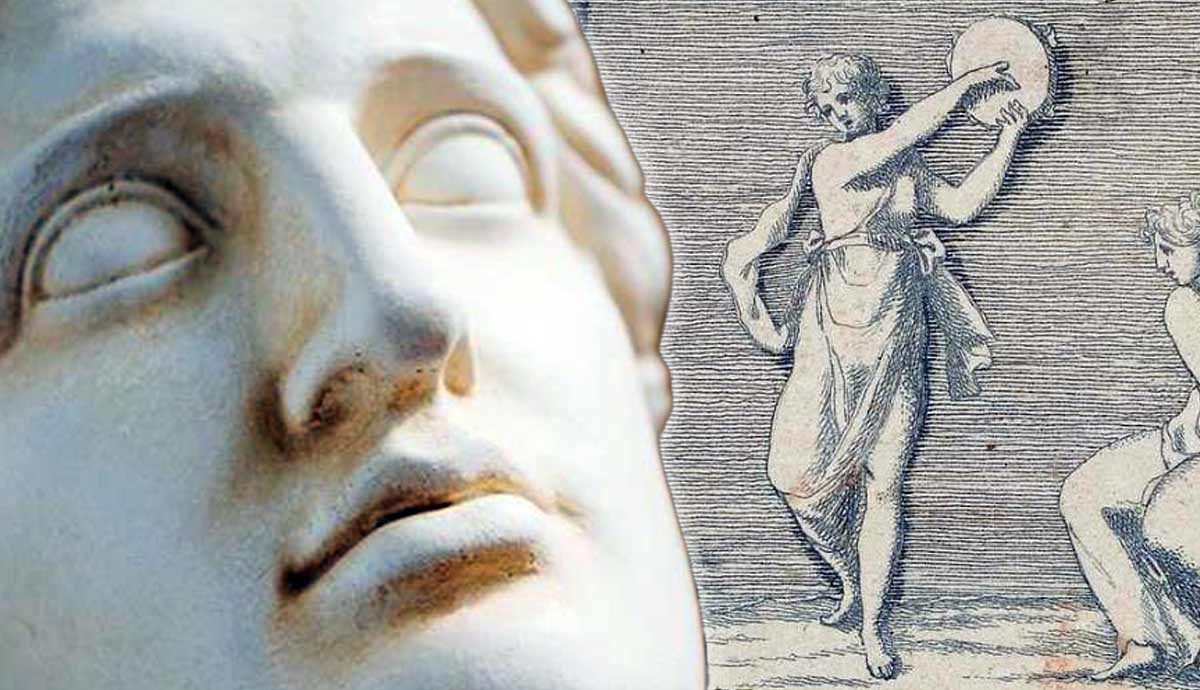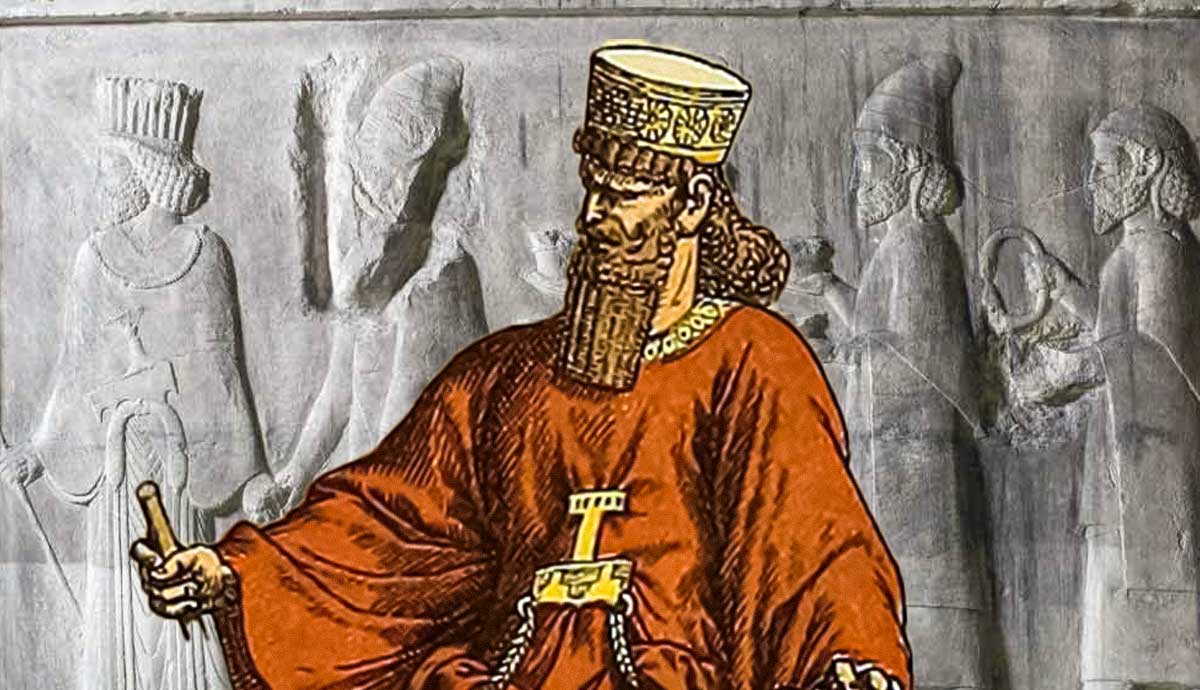
Julia Domna can stake a claim to being one of the most influential women of the Roman Empire. Aside from perhaps the indomitable Livia or the calculating Agrippina the Younger, there were few women who were so important in Rome’s history. Domna’s ideological importance—as imperial wife, mother, and even great-aunt—provided the platform for the Severan dynasty to rule for almost half a century (from 193-235 CE). As Augusta, she contended with deadly political intrigues, enjoyed unprecedented public prominence, cultivated a circle of poets and philosophers, and even left a lasting legacy on Rome’s urban fabric.
Eastern Aristocracy: Julia Domna and the Emesene Dynasty

Although she would eventually go on to be one of the most important people at the very heart of the Empire, Julia Domna’s story does not begin in Rome. The future empress was a native of Syria. Specifically, she was born in the city of Emesa (modern Homs), to a family of local aristocrats. This family, known to historians as the Emesene dynasty, had once been the rulers of this region, which had emerged following the breakdown of Seleucid power in the area. The city was wealthy and prosperous, having close connections to Palmyra in the east and the trade routes that connected Asia with the Mediterranean world.
Generally speaking, the Emesene rulers enjoyed good relations with the Romans, who had come to dominate the eastern Mediterranean world after Pompey’s conquests in the 1st century BCE. They were also evidently well known within Roman culture more generally. Cicero gave Pompey the nickname Sampisgeramus after one of the Emesene kings to mock his masquerading around as some kind of oriental king. One of the later Emese rulers, Sohaemus, offered soldiers to Vespasian during his wars in neighboring Commagene.

For reasons that remain unclear to historians, it was around the time of the early Flavians that the political autonomy of the Emesene dynasty was ended; there would be no more kings. However, this did not spell the end of the family’s local significance. Men from the family became the chief priests of the local cult of El-Gabal.
Unlike Greco-Roman gods, which were represented in human form, the god El-Gabal was worshiped in the form of a conical black stone (known as a baetyl). Coinage from the reign of Antoninus Pius shows the rock with an eagle perched atop it. Julia Domna’s father, Julius Bassianus, was the chief priest for this cult. While Bassianus’ elder daughter, Julia Maesa, was married off to Gaius Julius Avitus Alexianus, a native Syrian, the man who courted Domna’s hand in marriage would come from much further away.
Imperial Omens: Julia Domna and the Severan Dynasty

The Historia Augusta is not always the most reliable source for imperial history. As such, the story that Domna’s horoscope foretold that she would marry a king and that this is what drew Septimius Severus to her in the late 180s CE might initially seem farfetched. However, it is clear from corroborating sources, notably, Cassius Dio, that the future emperor was a keen believer in astrological signs and portents. Whether or not the marriage of Severus and Domna was spurred on by political ambitions, it was certainly a fruitful union. Wed in 186 CE, by 187 the couple were welcoming their first child. Lucius Septimius Bassianus – the future emperor Caracalla – was born at Lugdunum (Lyon) where his father was acting as the governor.

At this time, however, the political situation in Rome was deteriorating dramatically. The emperor Commodus, son of the vaunted Marcus Aurelius, was sinking into megalomania, even going so far as to perform in the arena as a gladiator! The Senate wearied of his madness and orchestrated the assassination of Commodus on New Year’s Eve, 192 CE. For the next four years, the Empire would be ravaged by civil war as no fewer than five men contested power. Severus was among them and it was he who would ultimately triumph. Although she would have been far removed from the battlefields where Severus’ successes were hard-won, Domna no doubt played a crucial role in his eventual triumph.

This is because of what Julia Domna represented on an abstract level. By the time of these civil wars, she had given Severus two sons. In other words, in his pitch to be emperor, Severus could now advertise future stability as a benefit of his rule. Whatever happened to him, he could assure people that there would be no descent into civil war and bloody political rivalry upon his death, as he had two heirs ready to take his place. Domna figured centrally in Severus’ ideological machinations during this period. In particular her maternal aspects were celebrated widely, including on coinage, in which she might be paired with her sons or represented with traditional maternal virtues such as fecundity.
She also became a mother to many more than just her two sons. Julia Domna was recognized as mater castrorum, or “mother of the camps.” Although she was not the first empress to receive this honorific (that was Faustina II, wife of Marcus Aurelius), the title symbolized the close connections between the army and the new Severan imperial dynasty. The soldiers’ loyalty was another crucial demonstration of the Severan promise of stability. As events would show, this was a promise the dynasty was not able to fulfill in the long term.
Rebuilding, Rhetoricians, and Rivals: Julia Domna the Empress

When Severus’ victory in the civil wars against his rivals was confirmed at the Battle of Lugdunum in 197, the new imperial dynasty could begin to make their mark on the Empire in earnest. In the imperial capital, Severus would prove to be a “builder emperor” on a scale not seen since the reign of Hadrian. As well as new structures, such as the Septizodium, Severus also oversaw the restoration of a number of Rome’s older monuments, including the Pantheon. Julia herself seems to have contributed to this urban rebuilding, notably with the restoration of the temple of Vesta in the Forum, which had been devastated by a fire during Commodus’ reign.
Julia Domna was also an extraordinarily visible empress. This reflected her pivotal role within Severan imperial ideology, in particular her role in guaranteeing future stability as the mother of the two Severan sons. This manifested itself in iconography, notably on coinage, as well as in grander public works of art. In Rome itself, Domna was represented on the Arch of the Argentarii in the Forum Boarium. This visibility was also evident elsewhere in the Empire. Julia Domna is represented prominently on the colossal Severan Arch, erected in Severus’ native city of Leptis Magna (modern Libya).

As Empress, Julia Domna was heavily involved in other aspects of Roman culture during the years of Severus’ reign. She cultivated a circle of philosophers and rhetoricians at court. This group of intellectuals included, most notably, Philostratus, a Greek sophist famous for his work Life of Apollonius of Tyana. This work recounts the tales of Apollonius, a Pythagorean philosopher from the 1st century CE.
Her prominent cultural role was also evident in her participation in the Ludi Saeculares (Secular Games). These were a significant religious festival, first inaugurated in 17 BCE during Augustus’ reign, to celebrate the dawning of a new age. In theory, the games were supposed to be celebrated only once every 100 years, but emperors could often put on the festival early as a way of generating support for their power, and different dating systems could be used to justify this. This is why the games were held by both Claudius and Domitian, despite there being just a few decades between the reigns of these emperors.
Despite this, Julia Domna’s life as empress was a dangerous one. In the patriarchal Roman society, Domna’s status and influence were directly connected to that of her husband and children, and being an emperor was an especially deadly job. The main danger faced by Severus during his reign was the alleged conspiracy of Plautianus. While acting as Severus’ Praetorian Prefect, Plautianus—who was a kinsman of Severus from Leptis Magna and allegedly his lover—amassed considerable wealth and prestige. When his daughter, Fulvia Plautilla, was married to Severus’ son Caracalla, it seemed to cement the union of the two families. It also may have given Plautianus bolder ambitions. Certainly, a close reading of the source material seems to indicate that his growing influence seems to have curtailed Domna’s status. Eventually, Caracalla, who hated Plautianus, convinced his father of the Prefect’s ambitions to have Severus killed so that he could rule instead.
Mother to a Fratricide: Julia Domna and Caracalla

Septimius Severus died in 211 at Eboracum (York) in the province of Britannia. Power passed peacefully to his two sons, Caracalla and Geta, and, for a little while at least, it seemed as though the rule of the Empire might be shared. However, the situation quickly became untenable. The siblings had had a fractious relationship since youth and now, as the two most powerful men in the Mediterranean, something had to give. According to Herodian, Domna herself tried to intervene, appealing to the boys’ love of their mother, but it was to no avail. Late in 211, Caracalla orchestrated the murder of his younger brother in the imperial palace. He then orchestrated the purge of Geta’s memory, known as damnatio memoriae, as statues, inscriptions, and even coins bearing the likeness of his brother were destroyed across the Empire. He is even alleged to have forbidden his mother to mourn the death of her son.
Ultimately, the impact of this fratricide on the relationship between mother and surviving son can only be speculated. This, it seems, is precisely what the Romans themselves did, leading to the later proliferation of the spiteful and salacious rumor that Caracalla and his mother in fact indulged in an incestuous relationship. The notion of this sexual relationship was linked to the false allegation that Domna was only Caracalla’s stepmother and that he was actually the son of Paccia Marciana, Severus’ first wife. However, this rumor is not recounted in Dio’s narrative. Given the senatorial historian’s dislike of Caracalla, it seems unlikely he would have missed an opportunity to criticize him given the chance. Instead, the rumor appears to have been more prevalent in the decades after Caracalla’s reign. Nevertheless, it does appear that the sharp-tongued residents of Alexandria were among the first to make the claim. According to Herodian, they mocked Domna by giving her the nickname Jocasta, referring to the mother and wife of Oedipus. They paid a heavy price for the scorn, as Caracalla ordered a massacre of the men of Alexandria in c. 215 when he visited the city.

To read the literary sources, Caracalla did not appear to devote significant consideration to the mundanities of rule. Instead, he was more interested in military conquest and especially in being viewed by his men as a commilito, a fellow soldier. He was certainly a more capable administrator than Dio and others would have us believe, and historians can trace Caracalla’s involvement in legal disputes from papyrological evidence. Nevertheless, it also seems true that the new emperor left some aspects of the imperial administration to his mother’s stewardship. As well as handling correspondence when he was on campaign, Dio notes that Julia Domna provided “excellent advice” to the emperor, as well as receiving delegations and responding to petitions from the populace. While it is important again not to overstate Domna’s political power or influence in this regard, it nevertheless shows her enduring central role in the imperial domus. Unfortunately for Domna, her time at the top was drawing to an end.
The Equestrian at the End: Macrinus and Julia Domna’s Death

In 217 CE, the emperor Caracalla was cut down by the side of the road where he had stopped to relieve himself. Few emperors would suffer a more undignified ending. His assassination was part of a conspiracy led by Marcus Opellius Macrinus, one of the praetorian prefects. Although Macrinus had not struck the fatal blow himself, it appears that he had acted out of self-interest. Rumors from Rome had begun to arrive at Caracalla’s court in the east where he was campaigning, and these contained news of omens and oracles foretelling Macrinus’ rise to power. This must have been especially surprising to the prefect given his equestrian status. At the time of his accession to power, he was the first man to have ever risen to the rank of emperor from outside the senatorial class.
In fact, Julia Domna may have inadvertently played a part in the conspiracy that cost her son his life. While she was carrying out her administrative role, receiving and responding to imperial correspondence so as not to overburden Caracalla while he was planning his war against the Parthians, the damning letter, which warned of Macrinus’ conspiracy, was diverted away from the emperor and instead sent to Domna’s court at Antioch. The delay was crucial, as in the meantime, a separate letter was received by Macrinus, warning him that he would need to act quickly for his own safety.
It was unusual for imperial women to suffer the same fate as their murdered menfolk—Caligula’s wife was a notable exception to this rule—and Domna was no different. She was, to begin with at least, treated with due deference by Macrinus. However, it appears that Domna, who in the space of only a few years had lost both sons and her husband, was not willing to continue in a world where she would no longer be the Augusta. At the age of roughly 57, Julia Domna starved herself to death in 217 CE.
Succession: Julia Domna and the Severan Revival

That was not the end of Julia Domna’s story. While it was uncommon for imperial women to be murdered along with their husbands or sons, Macrinus must have recognized that Julia Domna was not like many other imperial women. As both the wife and mother of former emperors, she was very strongly connected to the machinations of imperial power, with networks to powerful wealthy allies. She represented a significant danger to Macrinus’ imperial ambitions. It would take the new emperor less than a year to realize this.

Julia Domna’s older sister, Julia Maesa, was based in the east at the same time, where she had been overseeing the upbringing of her two grandsons in their native Emesa. Having heard of the death of her nephew Caracalla, and of her sister, Maesa would lead a revolt against the new emperor. Of course, as a woman, she could not be the rival and replacement to Macrinus. Instead, the older of her two grandsons would be presented as the alternative to Macrinus’ authority. At the time, this youth, who was just 14, was the chief priest of the local cult of El Gabal at Emesa. By the time of his eventual triumph over Macrinus and his advance to Rome, the boy would take his cult with him and attempt to introduce it into the imperial capital. Thanks to his singular devotion, he is known to modern audiences by the nickname Elagabalus.
Although Domna played no real role in the downfall of Macrinus and the rise of Elagabalus (and later, his cousin, Severus Alexander), she was nevertheless a crucial link to power. Elagabalus was presented as the illegitimate son of Caracalla and therefore he was the revival of the Severan dynasty. Domna was, consequently, the central figure connecting the two halves of this imperial dynasty. It was a fitting end to the life and story of one of Rome’s most remarkable imperial women.










